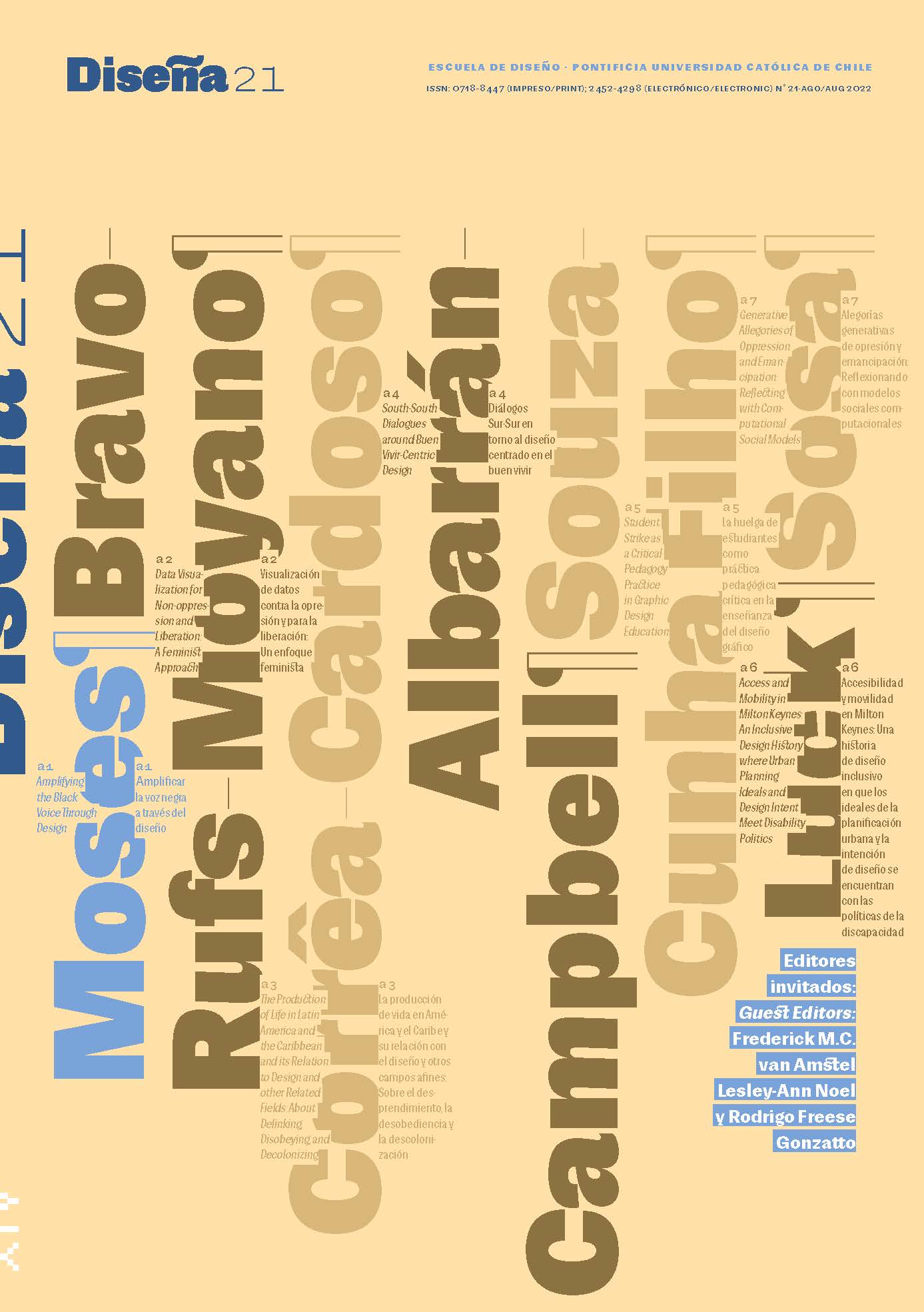Amplifying the Black Voice Through Design
Main Article Content
Abstract
Minneapolis experienced another devastating occurrence: the murder of an unarmed black man by the police in the midst of the national trial of Derek Chauvin. While the community continued to grieve the injustices against George Floyd, police officer Amy Potter shot and killed Daunte Wright on April 11th, 2021. To inspire unity amongst organizers and protestors, I created typography inspired by the Movement for Black Lives, and messages to unify what we all were, and still are, fighting for. My work is open-source and used on t-shirts, hoodies, posters, and pins, which I organized to be distributed for free within the community. Throughout this visual essay, I will discuss the importance of community protest as a tool for racial justice, and how design can provide an opportunity to support and uplift the voice of Black people.
Article Details

This work is licensed under a Creative Commons Attribution-ShareAlike 4.0 International License.

This work is licensed under a Creative Commons Attribution-ShareAlike 4.0 International license.
COPYRIGHT NOTICE
All contents of this electronic edition are distributed under the Creative Commons license of "Attribution-ShareAlike 4.0 Internacional" (CC-BY-SA). Any total or partial reproduction of the material must mention its origin.
The rights of the published images belong to their authors, who grant to Diseña the license for its use. The management of the permits and the authorization of the publication of the images (or of any material) that contains copyright and its consequent rights of reproduction in this publication is the sole responsibility of the authors of the articles.
References
Baldwin, J. (1961, July 15). James Baldwin Discusses his Book, “Nobody Knows my Name: More Notes of a Native Son” [Interview with Studs Terkel]. Studs Terkel Radio Archive; The Chicago History Museum. https://studsterkel.wfmt.com/programs/james-baldwin-discusses-his-book-nobody-knows-my-name-more-notes-native-son
Bieber, A., Gavin, F., Klanten, R., Servert, A., & Dexter, L. (Eds.). (2022). The Art of Protest: Political Art and Activism. Gestalten.
Borzi, P. (2020, June 1). Why are Cops in Minnesota so Rarely Charged in Officer-involved Deaths? MinnPost. https://www.minnpost.com/metro/2020/06/why-are-cops-in-minnesota-so-rarely-charged-in-officer-involved-deaths/
brown, adrienne maree. (2019). adrienne maree brown on Creating the Future [Interview with Alice Grandoit]. Deem Journal Online. https://www.deemjournal.com/stories/amb
Cole, M. D. (2021). Mel D. Cole: American Protest: Photographs 2020–2021. Damiani.
DuBois, D., W. E. B. (1926). Criteria of Negro Art [Originally published in The NAACP Crisis Magazine]. WEBDuBois.Org. http://www.webdubois.org/dbCriteriaNArt.html
Durant, S. (Ed.). (2014). Black Panther: The Revolutionary Art of Emory Douglas (Rev. ed.). Rizzoli.
Gaiter, C. (2018). Visualizing a Black Future: Emory Douglas and the Black Panther Party. Journal of Visual Culture, 17(3), 299–311. https://doi.org/10.1177/1470412918800007
Garza, A. (2013, July 13). A Love Letter to Black People. Facebook.
Lupton, E. (2017). Design Is Storytelling. Cooper Hewitt, Smithsonian Design Museum.
McFarlane, A. (2021, April 26). Guilty, Guilty, Guilty. Insight News. https://www.insightnews.com/news/guilty-guilty-guilty/article_b22f9b80-a70e-11eb-b693-37abe8a254e4.html
McGlone, P. (2016, March 1). 'This Ain’t Yo Mama’s Civil Rights Movement' T-shirt from Ferguson donated to Smithsonian Museum. Washington Post. https://www.washingtonpost.com/news/arts-and-entertainment/wp/2016/03/01/this-aint-yo-mamas-civil-rights-movement-t-shirt-from-ferguson-donated-to-smithsonian/
McQuiston, L. (2019). Protest!: A History of Social and Political Protest Graphics. Princeton University Press.
Moses, T., & Mercer, L. E. (2018). Racism Untaught – Revealing & Unlearning Racialized Design. Racism Untaught. https://racismuntaught.com/
Reed, T. V. (2019). The Art of Protest: Culture and Activism from the Civil Rights Movement to the Streets of Seattle (2nd ed.). University of Minnesota Press.
Tofighian, O., Swain, R., Pigram, D., Ra, B., Connell, C., Brown, E. J., Shaheen, F., Assaad, I. E., Currie-Richardson, L., Wheen, M., Bero, C. (S.), & Lopez, Z. (2022). Performance as Intersectional Resistance: Power, Polyphony and Processes of Abolition. Humanities, 11(1), 28. https://doi.org/10.3390/h11010028
Willen, B., & Strals, N. (2009). Lettering & Type: Creating Letters and Designing Typefaces. Princeton Architectural Press.
Xia, L. (2021). Action. In E. Lupton, J. Tobias, J. Halstead, K. Sales, F. Kafei, & V. Vergara, Extra Bold: A Feminist, Inclusive, Anti-racist, Nonbinary Field Guide for Graphic Designers (pp. 212–213). Princeton Architectural Press.

